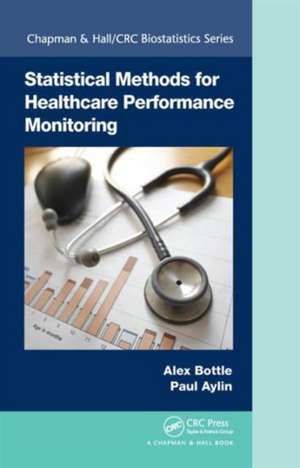Statistical Methods for Healthcare Performance Monitoring: Chapman & Hall/CRC Biostatistics Series
Autor Alex Bottle, Paul Aylinen Limba Engleză Hardback – aug 2016
Statistical Methods for Healthcare Performance Monitoring covers measuring quality, types of data, risk adjustment, defining good and bad performance, statistical monitoring, presenting the results to different audiences and evaluating the monitoring system itself. Using examples from around the world, it brings all the issues and perspectives together in a largely non-technical way for clinicians, managers and methodologists.
Statistical Methods for Healthcare Performance Monitoring is aimed at statisticians and researchers who need to know how to measure and compare performance, health service regulators, health service managers with responsibilities for monitoring performance, and quality improvement scientists, including those involved in clinical audits.
| Toate formatele și edițiile | Preț | Express |
|---|---|---|
| Paperback (1) | 434.45 lei 6-8 săpt. | |
| CRC Press – 13 dec 2021 | 434.45 lei 6-8 săpt. | |
| Hardback (1) | 673.22 lei 6-8 săpt. | |
| CRC Press – aug 2016 | 673.22 lei 6-8 săpt. |
Din seria Chapman & Hall/CRC Biostatistics Series
-
 Preț: 386.63 lei
Preț: 386.63 lei - 5%
 Preț: 338.18 lei
Preț: 338.18 lei - 5%
 Preț: 656.97 lei
Preț: 656.97 lei -
 Preț: 341.43 lei
Preț: 341.43 lei -
 Preț: 355.92 lei
Preț: 355.92 lei - 8%
 Preț: 432.16 lei
Preț: 432.16 lei -
 Preț: 354.78 lei
Preț: 354.78 lei -
 Preț: 342.90 lei
Preț: 342.90 lei -
 Preț: 288.81 lei
Preț: 288.81 lei -
 Preț: 312.36 lei
Preț: 312.36 lei - 9%
 Preț: 644.58 lei
Preț: 644.58 lei - 8%
 Preț: 376.64 lei
Preț: 376.64 lei -
 Preț: 372.30 lei
Preț: 372.30 lei -
 Preț: 356.64 lei
Preț: 356.64 lei - 8%
 Preț: 531.51 lei
Preț: 531.51 lei - 9%
 Preț: 608.33 lei
Preț: 608.33 lei - 9%
 Preț: 766.28 lei
Preț: 766.28 lei -
 Preț: 378.12 lei
Preț: 378.12 lei -
 Preț: 356.64 lei
Preț: 356.64 lei - 9%
 Preț: 682.94 lei
Preț: 682.94 lei - 9%
 Preț: 594.80 lei
Preț: 594.80 lei -
 Preț: 311.47 lei
Preț: 311.47 lei -
 Preț: 362.08 lei
Preț: 362.08 lei - 9%
 Preț: 833.75 lei
Preț: 833.75 lei - 9%
 Preț: 683.12 lei
Preț: 683.12 lei - 9%
 Preț: 681.83 lei
Preț: 681.83 lei -
 Preț: 370.53 lei
Preț: 370.53 lei - 9%
 Preț: 940.39 lei
Preț: 940.39 lei - 18%
 Preț: 791.14 lei
Preț: 791.14 lei - 18%
 Preț: 702.37 lei
Preț: 702.37 lei - 18%
 Preț: 1730.31 lei
Preț: 1730.31 lei - 28%
 Preț: 875.16 lei
Preț: 875.16 lei - 18%
 Preț: 786.89 lei
Preț: 786.89 lei - 25%
 Preț: 825.63 lei
Preț: 825.63 lei - 15%
 Preț: 678.14 lei
Preț: 678.14 lei - 25%
 Preț: 557.58 lei
Preț: 557.58 lei - 29%
 Preț: 625.83 lei
Preț: 625.83 lei - 18%
 Preț: 786.38 lei
Preț: 786.38 lei - 25%
 Preț: 778.07 lei
Preț: 778.07 lei - 25%
 Preț: 628.29 lei
Preț: 628.29 lei - 18%
 Preț: 1124.97 lei
Preț: 1124.97 lei - 28%
 Preț: 881.75 lei
Preț: 881.75 lei - 25%
 Preț: 526.81 lei
Preț: 526.81 lei - 18%
 Preț: 797.46 lei
Preț: 797.46 lei - 15%
 Preț: 479.86 lei
Preț: 479.86 lei - 18%
 Preț: 1017.63 lei
Preț: 1017.63 lei
Preț: 673.22 lei
Preț vechi: 792.03 lei
-15% Nou
Puncte Express: 1010
Preț estimativ în valută:
128.84€ • 134.01$ • 106.36£
128.84€ • 134.01$ • 106.36£
Carte tipărită la comandă
Livrare economică 12-26 aprilie
Preluare comenzi: 021 569.72.76
Specificații
ISBN-13: 9781482246094
ISBN-10: 1482246090
Pagini: 291
Ilustrații: 12
Dimensiuni: 156 x 234 x 21 mm
Greutate: 0.54 kg
Ediția:1
Editura: CRC Press
Colecția CRC Press
Seria Chapman & Hall/CRC Biostatistics Series
ISBN-10: 1482246090
Pagini: 291
Ilustrații: 12
Dimensiuni: 156 x 234 x 21 mm
Greutate: 0.54 kg
Ediția:1
Editura: CRC Press
Colecția CRC Press
Seria Chapman & Hall/CRC Biostatistics Series
Cuprins
Introduction
The need for performance monitoring
Measuring and monitoring quality
The need for this book
Who is this book for and how should it be used?
Common abbreviations used in the book
Acknowledgments
Origins and examples of monitoring systems
Origins
Healthcare scandals
Examples of monitoring schemes
Goals of monitoring
Choosing the unit of analysis and reporting
Issues principally concerning the analysis
Issues more relevant to reporting: attributing performance to a given unit in a system
What to measure: choosing and defining indicators
How can we define quality?
Common indicator taxonomies
The particular challenges of measuring patient safety
The particular challenges of multimorbidity
Measuring the health of the population and quality of the whole healthcare system
Efficiency and value
Features of an ideal indicator
Steps in construction and common issues in definition
Validation of indicators
Some strategies for choosing among candidates
Time to go: when to withdraw indicators
Conclusion
Sources of data
How to assess data quality
Administrative data
Clinical registry data
The accuracy of administrative and clinical databases compared
Indicent reports and other ways to capture safety events
Surverys
Other sources
Other issues concering data sources
Conclusion
Risk-adjustment principles and methods
Risk adjustment and risk prediction
When and why should we adjust for risk?
Alteratives to risk adjustment
What factors should be adjust for?
Selecting an initial set of candidate variables
Dealing with missing and extreme values
Timing of the risk factor measurement
Building the model
Output the observed and model-predicted outcomes
Ratios versus differences
Deriving SMRs from standardisation and logistic regression
Other fixed effects approaches to generate an SMR
Random effects based SMRs
Marginal versus multilevel models
Which is the "best" modelling approach overall?
Further reading on producing risk-adjusted outcomes by unit
Composite measures
Some examples
Steps in the construction
Some real examples
Pros and cons of composites
Setting performance thresholds and defining outliers
Defining acceptable performance
Bayesian methods for comparing providers
Statistical process control and funnel plots
Multiple testing
Ways of assessing variation between units
How much variation is "acceptable"?
The impact on outlier status of using fixed versus random effects to derive SMRs
How reliably can we detect poor performance?
Some resources for quality improvement methods
Making comparisons across national borders
Examples of multinational patient-level databases
Challenges
Interpreting apparent differences in performance between countries
Conclusion
Presenting the results to stakeholders
Main ways of presenting comparative performance data
Effect on behaviour of the choice of format when providing performance data
Importance of the method of presentation
Examples of giving performance information to units
Examples of giving performance information to the public
Metadata
Evaluating the monitoring system
Study design and statistical approaches to evalutating a monitoring system
Economic evaluation methods
Concluding thoughts
Simple versus complex
Specific versus general
The future
References
Appendix: glossary of main statistical terms used
The need for performance monitoring
Measuring and monitoring quality
The need for this book
Who is this book for and how should it be used?
Common abbreviations used in the book
Acknowledgments
Origins and examples of monitoring systems
Origins
Healthcare scandals
Examples of monitoring schemes
Goals of monitoring
Choosing the unit of analysis and reporting
Issues principally concerning the analysis
Issues more relevant to reporting: attributing performance to a given unit in a system
What to measure: choosing and defining indicators
How can we define quality?
Common indicator taxonomies
The particular challenges of measuring patient safety
The particular challenges of multimorbidity
Measuring the health of the population and quality of the whole healthcare system
Efficiency and value
Features of an ideal indicator
Steps in construction and common issues in definition
Validation of indicators
Some strategies for choosing among candidates
Time to go: when to withdraw indicators
Conclusion
Sources of data
How to assess data quality
Administrative data
Clinical registry data
The accuracy of administrative and clinical databases compared
Indicent reports and other ways to capture safety events
Surverys
Other sources
Other issues concering data sources
Conclusion
Risk-adjustment principles and methods
Risk adjustment and risk prediction
When and why should we adjust for risk?
Alteratives to risk adjustment
What factors should be adjust for?
Selecting an initial set of candidate variables
Dealing with missing and extreme values
Timing of the risk factor measurement
Building the model
Output the observed and model-predicted outcomes
Ratios versus differences
Deriving SMRs from standardisation and logistic regression
Other fixed effects approaches to generate an SMR
Random effects based SMRs
Marginal versus multilevel models
Which is the "best" modelling approach overall?
Further reading on producing risk-adjusted outcomes by unit
Composite measures
Some examples
Steps in the construction
Some real examples
Pros and cons of composites
Setting performance thresholds and defining outliers
Defining acceptable performance
Bayesian methods for comparing providers
Statistical process control and funnel plots
Multiple testing
Ways of assessing variation between units
How much variation is "acceptable"?
The impact on outlier status of using fixed versus random effects to derive SMRs
How reliably can we detect poor performance?
Some resources for quality improvement methods
Making comparisons across national borders
Examples of multinational patient-level databases
Challenges
Interpreting apparent differences in performance between countries
Conclusion
Presenting the results to stakeholders
Main ways of presenting comparative performance data
Effect on behaviour of the choice of format when providing performance data
Importance of the method of presentation
Examples of giving performance information to units
Examples of giving performance information to the public
Metadata
Evaluating the monitoring system
Study design and statistical approaches to evalutating a monitoring system
Economic evaluation methods
Concluding thoughts
Simple versus complex
Specific versus general
The future
References
Appendix: glossary of main statistical terms used
Recenzii
"… Overall, the book provides an interesting and easily accessible overview on health care performance monitoring and the statistical methods associated with it. Each chapter has a short overview at the beginning and sometimes a conclusion at the end, so it can also serve as a reference book. According to the authors, this book is not primarily aimed at statisticians, but all who want to compare and measure health care performance. The level of statistics obtained from an undergraduate nursing or medical degree is enough to follow. Furthermore, the authors marked several chapters and subchapters more heavy on statistics that can be skipped without missing the big picture. The rich examples make the book enjoyable to read and it has my unconditional recommendation to all interested in the topic."
—Christoph F. Kurz, Helmholtz Zentrum Munich, in Biometrics, March 2018
"Bottle and Aylin offer readers a practical approach to performance measurement, and the statistical tools to get it right. This topic may seem dry and arcane until you realize that these methods are what patients and policymakers depend on to tell a good hospital from a dangerous one, and a superb physician from a quack. In fact, the authors learned their trade investigating some of the most famous cases of medical scandals in the world, including a hospital whose errors killed dozens of babies, and a murderous physician who killed scores of patients. So, the lessons in this book matter. Highly recommended."
—Robert M. Wachter, MD, Professor and Chair, Department of Medicine, University of California, San Francisco
"Improving healthcare and ensuring patient safety relies on timely, valid and understandable information. Healthcare systems are awash with data but this seldom translates into useful information. The great value of this book lies in the combination of statistical sophistication with an understanding of the healthcare context and a practical concern for improving the care of patients. Alex Bottle and Paul Aylin have done us a great service by sharing their extensive expertise and showing us how healthcare can be effectively monitored and improved."
—Charles Vincent, Professor of Psychology, University of Oxford, and Emeritus Professor Clinical Safety Research, Imperial College London
"This book is the most thorough, comprehensive and practical review of hospital performance monitoring available to my knowledge. Although a statistical manual, it is not overly technical with very few formulae, and covers the ground in a logical way. It is replete with examples and I particularly like the tabulations of pros and cons of different methods and approaches and summaries of current controversies.
It discusses real-world issues which affect policy makers, practitioners and researchers alike and will be of value to all. I wish I'd had this book when I was working in this area. I can strongly recommend to anyone wishing to embark on the complexities of performance monitoring, and everyone who is already engaged in this area."
—Julian Flowers, Head of Public Health Data Science, Public Health England
—Christoph F. Kurz, Helmholtz Zentrum Munich, in Biometrics, March 2018
"Bottle and Aylin offer readers a practical approach to performance measurement, and the statistical tools to get it right. This topic may seem dry and arcane until you realize that these methods are what patients and policymakers depend on to tell a good hospital from a dangerous one, and a superb physician from a quack. In fact, the authors learned their trade investigating some of the most famous cases of medical scandals in the world, including a hospital whose errors killed dozens of babies, and a murderous physician who killed scores of patients. So, the lessons in this book matter. Highly recommended."
—Robert M. Wachter, MD, Professor and Chair, Department of Medicine, University of California, San Francisco
"Improving healthcare and ensuring patient safety relies on timely, valid and understandable information. Healthcare systems are awash with data but this seldom translates into useful information. The great value of this book lies in the combination of statistical sophistication with an understanding of the healthcare context and a practical concern for improving the care of patients. Alex Bottle and Paul Aylin have done us a great service by sharing their extensive expertise and showing us how healthcare can be effectively monitored and improved."
—Charles Vincent, Professor of Psychology, University of Oxford, and Emeritus Professor Clinical Safety Research, Imperial College London
"This book is the most thorough, comprehensive and practical review of hospital performance monitoring available to my knowledge. Although a statistical manual, it is not overly technical with very few formulae, and covers the ground in a logical way. It is replete with examples and I particularly like the tabulations of pros and cons of different methods and approaches and summaries of current controversies.
It discusses real-world issues which affect policy makers, practitioners and researchers alike and will be of value to all. I wish I'd had this book when I was working in this area. I can strongly recommend to anyone wishing to embark on the complexities of performance monitoring, and everyone who is already engaged in this area."
—Julian Flowers, Head of Public Health Data Science, Public Health England
Descriere
Statistical Methods for Healthcare Performance Monitoring covers measuring quality, types of data, risk adjustment, defining good and bad performance, statistical monitoring, presenting the results to different audiences and evaluating the monitoring system itself. Using examples from around the world, it brings all the issues and perspectives together in a largely non-technical way for clinicians, managers and methodologists.
Notă biografică
Dr. Alex Bottle is a Senior Lecturer at Imperial College London, UK
Dr. Paul Aylin is a Professor at Imperial College London, UK
Dr. Paul Aylin is a Professor at Imperial College London, UK












